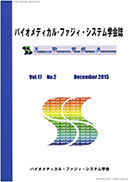Volume 25, Issue 2
Displaying 1-11 of 11 articles from this issue
- |<
- <
- 1
- >
- >|
-
2024Volume 25Issue 2 Pages Cover1-
Published: 2024
Released on J-STAGE: March 21, 2024
Download PDF (1780K) -
2024Volume 25Issue 2 Pages Toc1-
Published: February 08, 2024
Released on J-STAGE: March 21, 2024
Download PDF (1175K) -
2024Volume 25Issue 2 Pages 1-6
Published: February 08, 2024
Released on J-STAGE: March 21, 2024
Download PDF (1363K) -
2024Volume 25Issue 2 Pages 7-16
Published: February 08, 2024
Released on J-STAGE: March 21, 2024
Download PDF (1145K) -
2024Volume 25Issue 2 Pages 17-23
Published: February 08, 2024
Released on J-STAGE: March 21, 2024
Download PDF (1016K) -
2024Volume 25Issue 2 Pages 25-33
Published: February 08, 2024
Released on J-STAGE: March 21, 2024
Download PDF (2571K) -
2024Volume 25Issue 2 Pages 35-44
Published: February 08, 2024
Released on J-STAGE: March 21, 2024
Download PDF (977K) -
2024Volume 25Issue 2 Pages 45-55
Published: February 08, 2024
Released on J-STAGE: March 21, 2024
Download PDF (984K) -
2024Volume 25Issue 2 Pages 57-64
Published: February 08, 2024
Released on J-STAGE: March 21, 2024
Download PDF (2244K) -
2024Volume 25Issue 2 Pages 65-72
Published: February 08, 2024
Released on J-STAGE: March 21, 2024
Download PDF (5583K) -
2024Volume 25Issue 2 Pages 73-82
Published: February 08, 2024
Released on J-STAGE: March 21, 2024
Download PDF (5647K)
- |<
- <
- 1
- >
- >|
